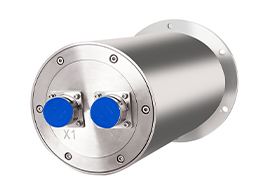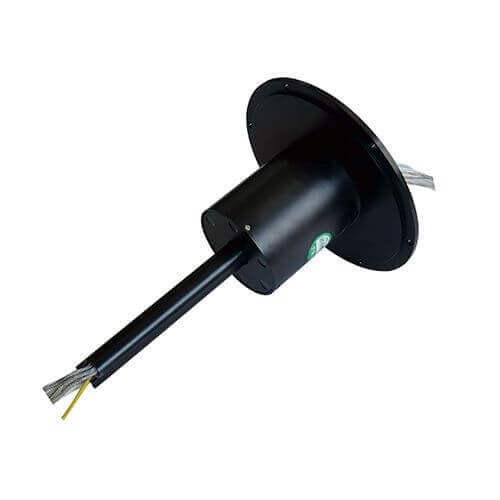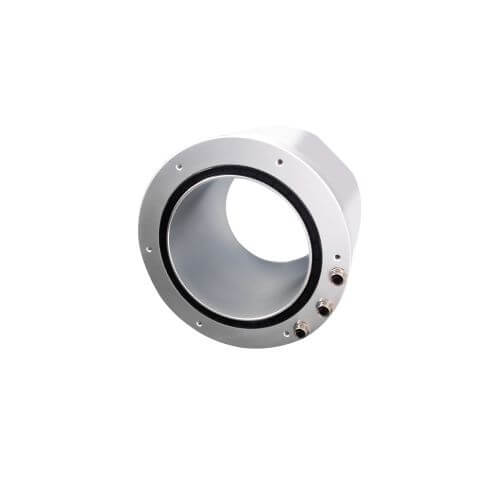In the intricate world of modern military technology, it’s often the less conspicuous components that play the most critical roles. One such integral but often overlooked component is the tank slip ring. A tank slip ring is a technologically advanced device significant to the functionality of modern combat tanks. Its primary role is to transmit power and exchange signals between the rotating parts and stationary areas of the tank, such as the turret and the hull.
Imagine the turret, the swiveling upper part of the tank that houses the primary armament, needing to rotate while the tank’s body stays stationary or moves in a different direction. How does it manage to maintain continuous and reliable communication without breaking the electric connection? The answer lies within the tank slip ring.
As a vital conduit, the slip ring ensures that rotating sections remain electrically connected to the static parts, fostering smooth data and power exchanges. This harmonious coordination aids not only in accurately maneuvering the vehicle but also in executing precise firing, maintaining seamless communication channels, and executing effective surveillance, irrespective of the turret’s orientation.
Thus, the tank slip ring stands as a pivotal backbone to modern tanks’ operation, shaping their superior navigation capabilities, attack precision, and real-time data responsiveness. It brings to light the intriguing blend of mechanical robustness and subtle sophistication that underlines modern military tanks’ monumental capacity.
The Importance and Functionality of Tank Slip Rings
The humble tank slip ring quietly holds a profound significance in maintaining the functionality of modern military tanks. At its core, a tank slip ring is an electromechanical device that facilitates the transmission of power and signals from a stationary structure to a freely rotating body— in this case, from the hull of a tank to its turret.
This unassuming role masks a plethora of benefits. First, it’s essential to understand that time and precision, in a military context, can spell the difference between victory and defeat. For an operator inside a tank, unrestricted rotation of the turret— independent of the tank’s body— with an uninterrupted flow of power and data, is crucial for quick responses in high-stakes situations. This unimpeded maneuverability, provided by tank slip rings, is vital for fast target acquisition and tracking, real-time information processing, and optimal weapon system operation.
Moreover, systems like cameras, sensors, radar, and other surveillance equipment housed in the turret heavily rely on the slip ring to function effectively. These instruments are continuously transmitting data to the tank’s systems. Regardless of whether the turret is stationary or rapidly rotating, the tank slip ring ensures that data flow and power transmission keep pace.
In essence, the tank slip ring’s role is akin to a vital artery, connecting the mobile and static parts of a tank. It allows various systems to function in unison — the turret can spin freely, the electrical connection remains undisrupted, and vital systems in the turret continue operating, all leading to enhanced functionality and efficiency of a modern tank. As such, a tank’s performance hinges heavily on these intelligent components, underlining their importance in the grand scheme of warfare technology.

Construction and Design of Tank Slip Rings
Tank slip rings are marvels of engineering, embodying a blend of intricate construction and material science. At a fundamental level, a tank slip ring consists of two key components: the rings, which are connected to the electrical circuits in the rotating body (like the turret), and brushes, which are arranged around the rings and connect to the stationary structure (like the body of the tank).
These rings and brushes, often made from advanced conductive materials such as copper alloys or precious metals, facilitate the flow of electrical power or signals between the stationary and rotating parts of a tank. They slide against each other, allowing an electrical current to be passed across without interrupting the movement of the turret.
Considering the demanding conditions that military tanks operate in, these slip rings need to be more than just functional. They must be rugged and resistant to a variety of harsh conditions. From withstanding high levels of vibrations to tolerating extreme temperatures, these slip rings follow military-grade specifications to ensure reliable operation in every situation.
Take, for example, the need for seamless conductivity even in adverse weather. Often, the materials used to construct these slip rings are chosen for corrosion resistance, ensuring that their performance remains unscathed even if exposed to moisture, dust, or other challenging environmental factors.
Furthermore, these slip rings must withstand the rigors of field operation without compromising on longevity or functionality. Hence, they’re often built with wear-resistant materials and designed to offer minimal maintenance needs, thereby ensuring extended longevity, even under heavy-duty cycling.
In conclusion, the design and construction of tank slip rings aren’t merely about creating a pathway for electrical communication. It’s a careful consideration of the operating environment, the rigors of field demands, and the need for stylistic integration, that makes these slip rings a marvel of enduring architectural prowess.
Different Types of Tank Slip Rings
There is a significant diversity in the types of slip rings used in tanks. The wide spectrum of design variations caters to different levels of functionality and integration, ensuring that the right slip ring meets the precise needs of each tank model. Here, we explore three common types of slip rings used in tanks: capsule slip rings, pancake slip rings, and through bore slip rings, each having its unique advantages and limitations.
Capsule Slip Rings
Capsule slip rings, compact and efficient, are usually encased in a closed shell or, as the name implies, a capsule. Their configuration allows multiple circuits, supporting the transfer of power, signals, or a combination of both. They’re generally used when space is limited. Though their size restricts the number of circuits they can handle, they offer smooth operations for medium-sized payloads, proving their efficiency despite their compact nature.

Pancake Slip Rings
On the other hand, pancake slip rings are an ideal choice when length is a constraint but the circumferential space isn’t as limited. The distinguishing feature of this type of slip ring is its flat, or “pancake,” shape. The rings are stacked on top of one another, with insulating material between each layer. The advantage is the slip ring’s length or height can be greatly reduced compared to cylindrical designs. At the same time, this configuration can make it more difficult to maintain brush contact and ensure even wear over long periods.

Through Bore Slip Rings
Lastly, through bore slip rings, also known as hollow shaft slip rings, have a central hole to accommodate shaft mounting or routing cables and pneumatic or hydraulic lines. They provide a versatile solution, accommodating more circuits, and can adopt additional rotary joints such as optical and fluidic. The central bore reduces the axial length, and the design can accommodate more load and handle higher speeds. The core restriction would be the necessary space required to house the slip ring, which may limit its usage in particularly compact environments.

In choosing the slip ring type, one must balance the needs of space restriction, the quantity of circuits required, and the environmental conditions they may be subject to. The array of types available is a testament to the flexible design and vast potential applications of slip rings in the world of tank design. Each type, with its particular attributes of structure, function, and limitation, contributes significantly to the remarkable efficiency and effectiveness of modern military tanks.
Installation and Maintenance of Tank Slip Rings
The functionality and lifespan of tank slip rings are partly influenced by how properly they’re installed and maintained. Thus, understanding the right procedures and following routine maintenance practices is integral to optimizing their performance.
Installation of Tank Slip Rings
Typically, the installation of tank slip rings is a meticulous process requiring planning and precision. Depending on the type of slip ring being installed (capsule, pancake, or through bore), procedures can vary, but some general rules apply. Slip rings are typically installed onto the tank’s hull or turret using suitable mounting options available on the specific slip ring housing.
During installation, avoid any high axial/radial forces on the slip ring, which may cause displacement or damage. It’s also essential to ensure that the slip ring has room for movement due to thermal expansion to prevent structural impairment under extreme temperature changes.
A common issue during installation is an improper connection, i.e., reversed power and signal cables, leading to system malfunctions. Meticulous checking of cable connections post-installation can help in avoiding these costly mistakes.
Maintenance of Tank Slip Rings
Maintenance of tank slip rings is as critical as their installation. Regular checks and routine maintenance help significantly in increasing slip rings’ lifespan and sustaining their optimal function.
Slip rings should be inspected for visible damage and wear routinely. Any physical damage may impair their performance and could have disastrous consequences in operation. Cleaning the slip ring is crucial, too, primarily since dust and other debris can cause poor connectivity or even complete failure.
In systems where wear is expected, regular replacement of worn-out brushes and contacts helps maintain the quality of electrical transmission. It’s equally essential to keep checking and tightening the mechanical attachments from time to time as vibrations could loosen these fixtures, causing weak contact and potential disruption in signal transmission.
Moreover, adopting proactive measures like temperature checks and monitoring performance can help detect potential problems early and prevent the expensive fallout of a system failure.
In sum, proper installation and maintenance of tank slip rings are crucial cornerstones in preserving their functionality and extending their service life. By adopting responsible practices, the performance and overall lifespan of these unsung heroes of tank technology can be significantly enhanced.
Tank Slip Rings Common Issues & Troubleshooting
Like any mechanical component, tank slip rings are not immune to issues and challenges. They can exhibit problems such as mechanical wear, dust accumulation, or even corrosion, each affecting their functionality. However, timely identification and swift troubleshooting can mitigate these problems, preserving their operational efficacy.
Common Issues
Mechanical wear: Since slip rings involve physical contact, wear and tear over time are inevitable. Continuous rotation can lead to the degradation of conductive materials, eventually affecting signal transmission and overall performance.
Dust accumulation: The dust can cause significant trouble for slip rings. It can create a non-conductive layer between the brushes and the rings, causing poor connectivity or even a complete failure of transmission.
Corrosion: Prolonged exposure to harsh environments like high humidity or salinity can cause corrosion of the conductive materials in the slip rings. Corrosion can impede proper conduction, leading to a drop in the operational efficiency of the slip ring.
Troubleshooting Measures
Each of these issues calls for specific troubleshooting measures. Here are a few basic steps to resolve them:
Mechanical wear: Regular inspection is key to mitigating mechanical wear. Look out for visible wear and tear signs, and replace the worn-out components promptly. Monitoring operational parameters like electrical noise can also help flag impending wear-related issues.
Dust accumulation: Regular cleaning is vital to combat dust accumulation. Using appropriate cleaning agents or compressed air can eliminate dust and debris from the rings and brushes. Care should be taken to avoid aggressive cleaning that might potentially damage the components.
Corrosion: If corrosion is identified, it’s necessary to replace the affected components to maintain functionality. To prevent future corrosion, apply appropriate protective seals or coatings if the slip ring is to be operated in harsh environments. Alternatively, choosing suitable materials that are inherently resistant to corrosion can also help.
In conclusion, while tank slip rings may encounter various issues, effective troubleshooting can resolve most of these problems. Recognizing the symptoms early, adopting appropriate measures, and performing regular preventive maintenance can ensure the longevity and continued performance of these pivotal components in a tank’s operational efficiency.
Tank Slip Rings – When to Seek Professional Help
While regular cleaning, inspection, and basic troubleshooting can happen at the user level, there are circumstances where professional expertise becomes necessary. Recognizing when to seek professional help is crucial because incorrectly handling more complex issues can lead to more significant tears, system failures, or compromising safety.
When to Engage Professional Help
- Persistent Issues: If a problem with the slip ring persists even after basic troubleshooting, it may indicate more complex underlying issues that demand professional help.
- Replacement of Major Components: Replacement of major slip ring components can be a delicate process that requires specialized knowledge. For instance, replacing the brushes or the rings themselves, if incorrectly done, might lead to an array of issues, from poor connectivity to completely dysfunctional slip rings.
- Significant System Malfunction: If the slip ring’s issues cause major system malfunctions or if there’s a significant drop in operational efficiency, it could be a cue to consult professionals.
Contacting Slip Ring Manufacturer or Professional Serviceman
For critical issues, it might be prudent to contact the slip ring manufacturer directly. Most manufacturers have their technical support teams skilled in diagnosing and resolving a wide variety of problems. In many cases, they can provide guidance remotely, either through phone or video calls.
Alternatively, engaging professional servicemen, preferably experienced in dealing with military-grade equipment, could be another option. Their hands-on experience across different settings and equipment types can provide quick and efficient resolution of issues.
In conclusion, while users can resolve basic slip ring issues, the rule of thumb should always be to err on the side of caution. Where there’s uncertainty or complexity, it’s wise to seek professional help. Ensuring the longevity and operational efficiency of tank slip rings, ultimately, is a blend of proactive user-level management and timely professional intervention.
Tank Slip Rings – Recent Developments and Future Trends
Tank slip ring technology, like all other technological sectors, is seeing transformative changes influenced by advances in materials, designs, and features. These evolutionary steps are set to redefine the future capability blueprint of tanks.
Recent Developments
High-Performance Materials: Recent years have witnessed the introduction of new materials in slip ring technology. In addition to traditional copper, compounds like precious metals and graphite now offer improved conductivity and enhanced resistance to wear and corrosion.
Improved Designs: Advances in design are enabling more compact and efficient integration. Slender designs, for instance, offer high performance without compromising space, marking a significant leap from the chunkier models of the past.
Advanced Features: Modern slip rings are incorporating advanced features like data transmission via Ethernet or fiber optics. These additions are paving the way for refined control systems and time-critical high-capacity data transmission, adding substantial operational worth to the tank systems.
Future Trends
Based on these developments, the future of tank slip rings will likely steer towards greater efficiency, data capacity, and improved durability:
More Sophisticated Systems: As slip rings evolve to deliver higher signal and power densities coupled with high-speed data transmission, we can expect a leap in the sophistication of tanks’ control and surveillance systems.
Innovation in Materials: We might witness the use of more durable and corrosion-resistant materials that can withstand extremely harsh environmental conditions while maintaining optimal performance.
AI & IoT in Tanks: The use of high-speed data transmission and real-time signal capability in slip rings could enable the integration of Artificial Intelligence (AI) and the Internet of Things (IoT) in tank operations, providing finer control and instant battlefield data analysis.
In summary, recent developments and projected trends in slip ring technology hold promises of unprecedented evolutionary strides in military and defense operations. As this technology continues to improve and mature, the pivotal role it plays in adding to the potency and effectiveness of tank systems will only become more pronounced.
Conclusion
The importance of understanding tank slip rings and their role in modern military tanks cannot be overstated. Despite being unobtrusive in presence, their vital functions make them the backbone of tank operation. As advancements continue to shape the future of these components, we can expect even more refined, resilient, and capable military tanks. Questions, thoughts, discussions? Feel free to engage and delve deeper into the intriguing world of tank slip rings.
See What We Can Do
